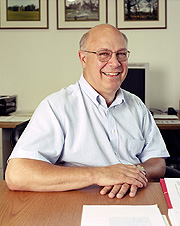After 42 years, Bruce Chrisman bids farewell to Fermilab
 |
Bruce Chrisman will retire from Fermilab this year. Photo: Reidar Hahn |
"Looking back, 1969 was a bad year to get a degree in physics," chuckled Bruce Chrisman. "Due to changes in government funding because of the Vietnam War, physicists were not exactly in demand in the late '60s and early '70s."
That may be true, but it didn't stop Chrisman, who went on to spend 42 years working in the field. Most of those years were here at Fermilab, including a recently concluded stint as chief operating officer of the laboratory. With his retirement on the horizon, Chrisman took a break one recent afternoon to reflect on his career.
That career started just after Chrisman graduated with a Ph.D. in physics from the University of Illinois. Lucky for him, his thesis professor's tennis partner was Ned Goldwasser, Fermilab's first deputy director, who hired Chrisman to work in the lab's film analysis facility.
"Fermilab was just two years old," Chrisman said. "There was no high-rise and office space was hard to come by. So I worked out of a kitchen in one of the homes in the Village."
But the limited space didn't dampen the excitement of helping to build a new scientific program in particle physics.
"In those early days of getting the Main Ring functioning, everyone had the opportunity to be a 'tunnel rat'. It was exciting times," he said.
University of Chicago, the bubble chamber and Yale
A few years later, Chrisman earned an M.B.A. from the University of Chicago and, at the same time, he moved from "doing" science to "administrating" science. While finishing up his last quarter at the University of Chicago in the spring of 1975, he became the executive assistant to the head of Fermilab's accelerator division. That same year, he published several papers on a bubble chamber experiment.
When the laboratory built the first extraction line to create antiprotons, Chrisman was the project manager. He was also heavily involved in the development of the Northern Illinois University neutron therapy facility at the laboratory.
He was later promoted to Fermilab's head of business services before leaving in 1983 to take a vice president position at Yale University – the first non-Yale grad to hold an officer title at the university.
From the kitchen to the board room
After a year in New Haven, Conn., Chrisman was missing the stimulating work and people at Fermilab, so he returned. In the late 1980s he worked on the contract for the Superconducting Super Collider in Texas and, in 1989, was the first person to relocate there to help set up the lab. After a few months, he left the SSC and the Universities Research Association for the second time in his career to manage a law firm in Chicago.
But by May 1991, the allure of physics and the lab had brought Chrisman back to Batavia again, this time for good.
Read more
—Deb Sebastian
Everyone is invited to attend the farewell symposium for Bruce Chrisman today from 3 to 5 p.m. in Ramsey Auditorium, as well as a reception on the Wilson Hall 2nd-floor crossover from 5 to 7 p.m.
|